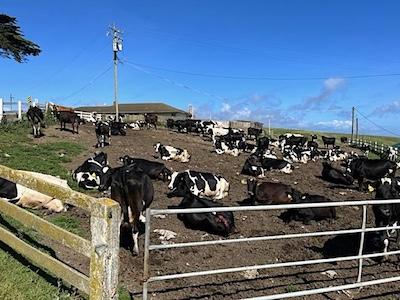
The National Park Service is losing money for not charging fair market value on livestock operations at Point Reyes National Seashore, according to Public Employees for Environmental Responsibility.
The National Park Service is failing to recover fair market value on the leases for beef and dairy ranches at Point Reyes National Seashore, according to Public Employees for Environmental Responsibility, which claims taxpayers are losing millions of dollars on the operations.
The advocacy group maintains that federal law and NPS policy requires the agency to require fair market value on the leases for the operations, yet it is charging "only a fraction of that amount."
Currently, 14 dairy and beef ranchers hold 21 leases that occupy approximately one-third of the entire seashore. The Park Service also manages ranches on 10,000 acres of the adjacent Golden Gate National Recreation Area. Together, these operations support 5,725 head of cattle, according to the national seashore’s 2021 decision to continue ranching for another 20 years.
These purely commercial operations serve no park purpose, argues PEER. While the national seashore draws more than 2 million visitors each year, barbed wire fences restrict park visitors from entering the leased dairy and ranch lands.
The issue of ranching on the national seashore has been controversial. The ranches operate in a rare arrangement under federal leases created after the Park Service purchased their lands by the early 1970s. They have become a growing flashpoint for environmental concerns over cattle impacts on the land and water and greenhouse gas emissions at the 71,000-acre seashore. Tangled up in the debate is the fate of endemic tule elk, which neared extinction in the mid-1800s but have rebounded and now compete with cattle for water and forage in parts of Point Reyes.
The grazing provisions of Point Reyes leases charge only $7/per animal unit (defined as a cow and a calf) per month, PEER said in a release. By contrast, the U.S. Department of Agriculture calculates the fair market value for an animal unit in California as $27.60/month per cow-calf for the latest year available. In addition, the ranchers' leases with the Park Service cover both land for grazing and, in many cases, multiple houses per ranch, as well as associated barns, sheds, and corrals. However, the operators do not pay anywhere near a fair market value leasing fee for residences and associated lands, the group maintains.
Point Reyes is in Marin County, which has some of the highest real estate values in the country. For example, one ranch has been leasing over 1,000 acres with five houses and grazing its 280 cattle on those lands for less than $2,000 per month, said PEER. Moreover, these private businesses pay no property tax while generating substantial revenue.
“We estimate that these below-market Point Reyes Seashore leases cost taxpayers around $3 million every year,” said Pacific PEER Director Jeff Ruch, noting the annual lease revenue is approximately $800,000 short of covering the seashore’s estimated costs for administering the leases. “Taxpayers should not be obligated to subsidize these private businesses.”
PEER on Monday asked that the Interior Department's inspector general audit the Point Reyes leases, as well as the similar leases in the Golden Gate National Recreation Area, to determine whether they are set at fair market value.
“The case for taxpayer support for the National Park Service is undermined by sweetheart deals such as those that have long been in place at Point Reyes,” Ruch added, pointing out that the leases for all the Point Reyes ranches and dairies expire in September of this year. “These commercial operations should start paying their fair share to use national park lands.”




 Support Essential Coverage of Essential Places
Support Essential Coverage of Essential Places







Comments
When the messenger has an obviously biased agenda, and has a vested interest in promoting that agenda, yes it's legitimate and NECESSARY to an informed discussion to point that out.
Look, I don't blame PEER for doing what they're doing or promoting their point of view, or for NPT for covering them. But like the NRA, Sierra Club, ATV advocacy groups, Crockett Club, Isaac Walton League, et al., their involvement in issues of outdoor recreation, conservation, and preservation is of limited value and insight, simply because they're so predictable and predictably lopsided and EVERYONE KNOWS IT! NONE of them add much insight to the debate--they're already lined up where they're lined up, they ain't gonna change, and everyone knows it. They add nothing to the debate.
isn't it worth assuming that since they have lawyers on staff, some of the salaries went for legal work? And some likely went to outside attorneys?
Now you're the one asssuming that PEER is using their "salaries" for legal assistance and resources for whistleblowers.
I assumed salaries were for salaries and that left $177,000 for legal assistance and resources for whistleblowers.
Unless PEER is willing to itemize just how they're funding legal assistance and resources for whistleblowers, I suppose we're all left to assume how PEER is using their funds.
Would PEER like to respond?
Sarah,
As you well know, these ranchers enjoy huge subsidies not available to the private sector. Furthermore, there is a long, detailed, and documented history of them *not* complying with lease terms. Additionally, your insinuations are inappropriate. A better way to express your question Why Now is, why not sooner. Regardless, the law is the law, and it's objectionable that so much time and effort has to be applied to enforcement in the face of all the political influence exerted to perpetuate abuse of supposedly protected public lands.
Judy,
With all due respect, this is disappointing fear-mongering. What you describe as chapparal and scrub "taking over" is regarding as restoration by any impartial ecologist. Additionally, the red-legged frog is a clear red-herring. All the specific studies as well as the vast majority of general literature on ranching indicate that the ranch operations in Point Reyes are a net-negative for the health of the environment. Finally, the law is the law, isn't it?
The cattle compete with the native Tule elk.
Remove the cattle and their for-priofit operations.